Best exercise bikes 2025: for home workouts this fall & winter, all tested and rated
Improve your warm-up, get your legs spinning or add cardio to your training with the best exercise bikes, that are always ready to ride.

Matt Ischt-Barnard

The best exercise bike is one that inspires you to keep riding no matter the weather outside, helping you stay on top of your fitness goals and keep your legs spinning. Exercise bikes have undergone significant evolution in recent years, with many now offering motivational features, large supportive communities, and built-in personal trainers.
Exercise bikes are also becoming more connected, with features you would only expect from the best indoor smart bikes, such as third-party ride app integration and seamless connectivity to the best smartwatches and best heart rate monitors, allowing you to utilise more advanced training techniques.
Exercise bikes serve as an excellent starting point for individuals aiming to enhance their fitness and training. They provide straightforward, user-friendly interfaces that elevate your heart rate and engage your legs. Depending on your preferences, three types of resistance are available. Manual resistance bikes offer easy dial adjustments, making them ideal for quick cardio sessions and warm-ups. Wind-resistance bikes engage the legs but sometimes the arms, making them exceptional for cross-training; the more effort you exert, the greater the resistance. Lastly, electromagnetic bikes operate smoothly and quietly, making them well-suited for integration with third-party training applications.
In this guide, I have compiled seven of the best exercise bikes, as tested and rated by the Cycling Weekly team, including Domyos models. An in-house Decathlon brand, the Basic 100 delivers performance beyond its price point, which suggests it should. Of course, no guide to exercise bikes is complete without mentioning Peloton. Their ecosystem and community set the bar pretty high, but machines like the Echelon Smart Connect are now snapping at Peloton's coattails.
The Quick List
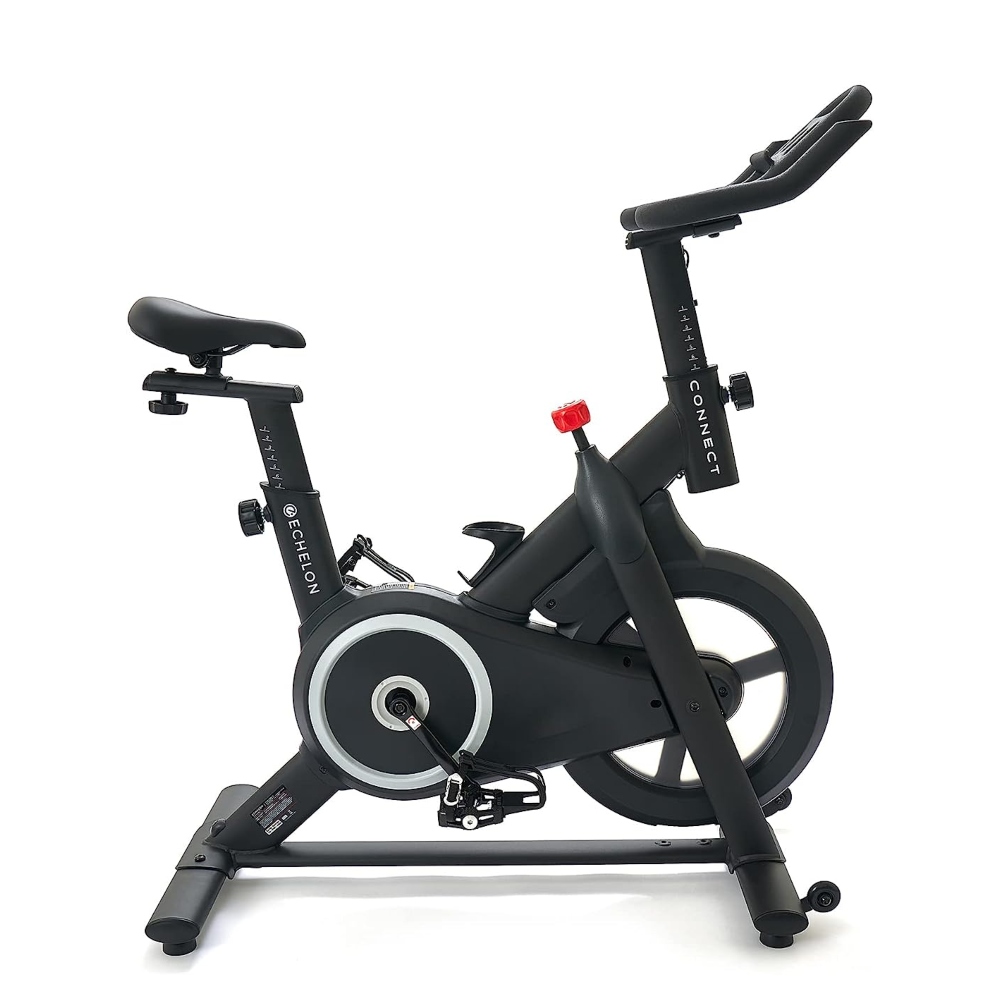
Keenly priced, the Echelon Connect bike boasts a silent magnetic flywheel and 32 resistance levels. Unlimited personal workouts for all levels are available via the dedicated app.
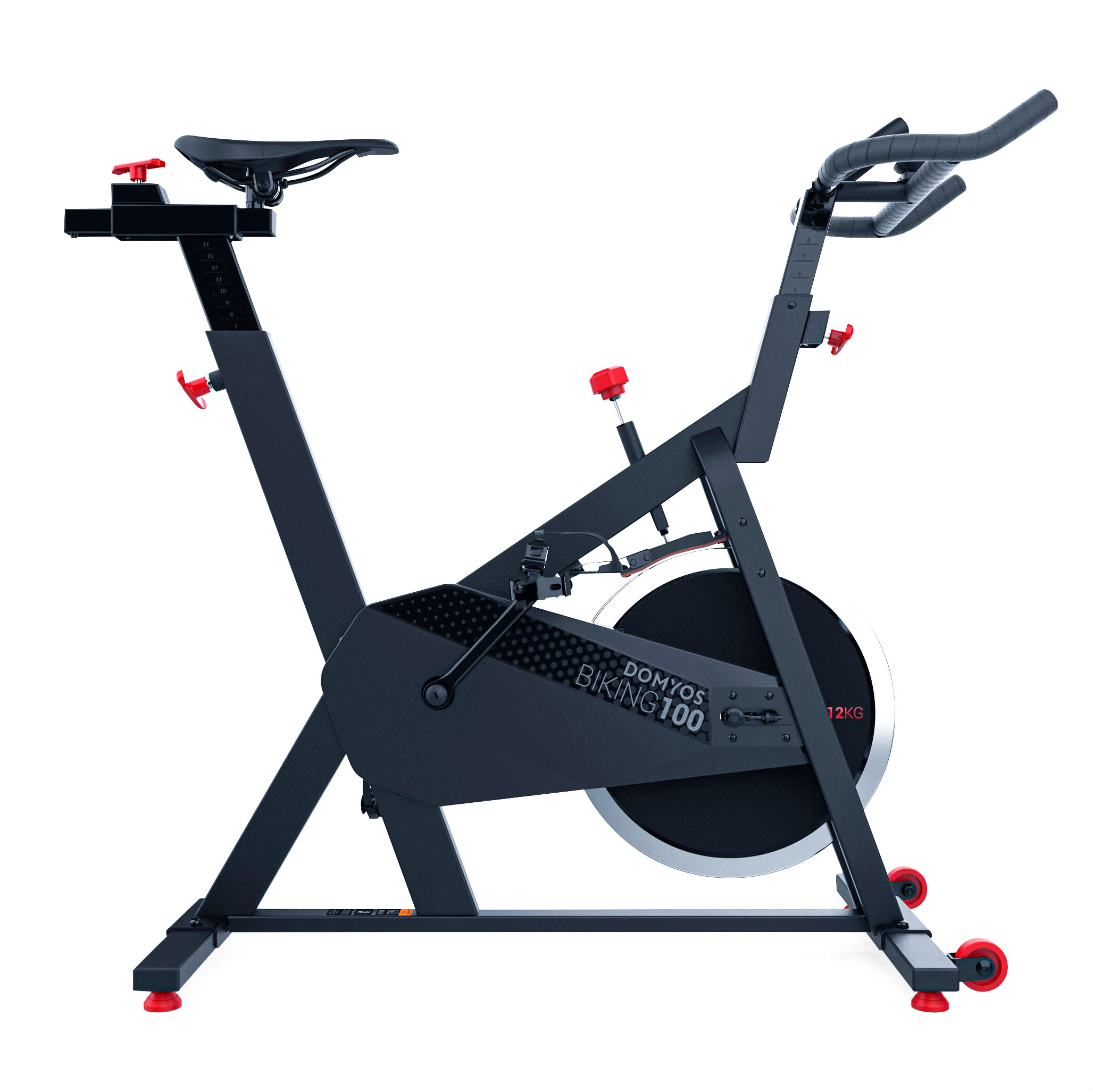
Both easy to set up and use, the Domyos exercise bike is ideally suited to those on a budget. It features a 12kg/26.4lbs flywheel and plenty of adjustability to help dial in the fit.

For riders who are looking to put the power down and have a reasonable level of self-motivation. Excellant levels of resistance adjustability keep it ahead of its competitors.

A budget-friendly option that could tempt dedicated cyclists with its excellant connectivity to third-party app platforms like Zwift and Strava.

Famed for its plethora of live classes, the Peloton bike is best suited to those who need help with structured workouts and training motivation. Requires a monthly subscription.

Developed for over a decade with some of the best cyclists and athletes around the world. The Air brings Wattbikes' renowned quality and high-intensity training platform into the home.
Load one more of the best exercise bikes

A simple, quiet, and smooth machine, the BikeErg has a lot to like. Its extremely light weight makes it ideal for those who need to move it around, and its low maintenance wind resistance should see it last forever.
Our pick of the best exercise bikes
Best Peloton alternative
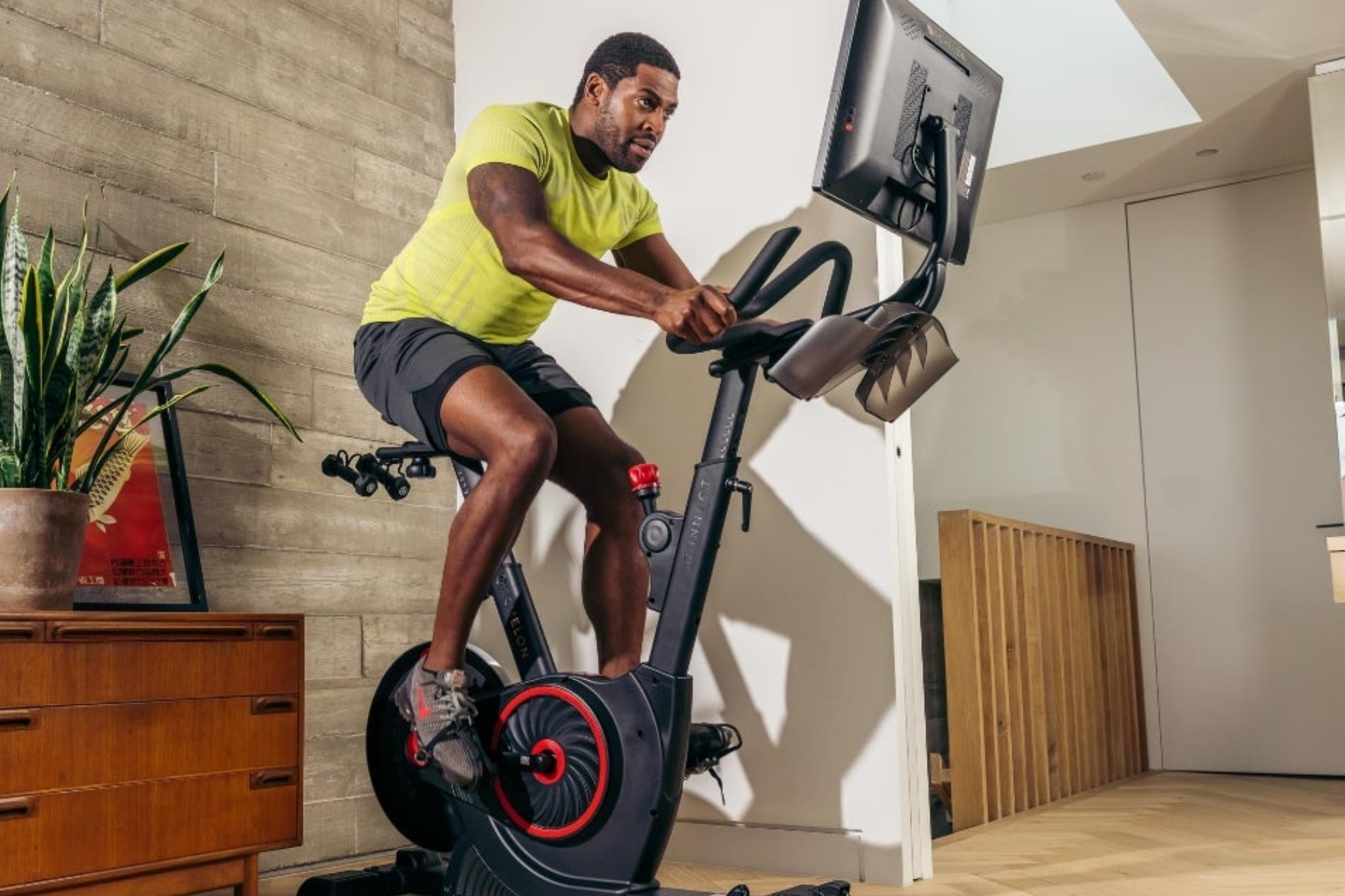
1. Echelon Smart Connect EX3
Best Peloton alternative
Resistance: Mechanical resistance and adjustment | Levels of resistance: 32 | Max rider weight: 299lbs/ 136kg | Height range: 4'5" - 6'8"/ 134cm -203cm | Bike weight: 103lbs/47kg | Display: Model depending | Third party connectivity: Yes | Subscription required: No, Free Ride mode offers basic metrics, For classes, premium membership is required
The Echelon smart bike is a sturdy and compact bike that provides both comfort and functionality. Customisation is easy with an adjustable oversized seat and handlebar console. A silent magnetic flywheel provides 32 levels of resistance and challenging workouts for all levels of rider.
A clear contender for the best Peloton alternatives, with unlimited personalised workouts and online community options. But unlike Peloton, all price plans allow you to join a variety of live and on-demand classes and special events led by Echelon's own trained instructors. Access is provided through the Echelon Fit App using your mobile phone, tablet or smart TV. Which can be held by the holder provided with the bike.
The bike provides a more upright riding position than other smart exercise bikes, so longer torso riders might feel a bit squished up, while others may find the ride feel too distant from their real road bike.
Best exercise bike on a budget
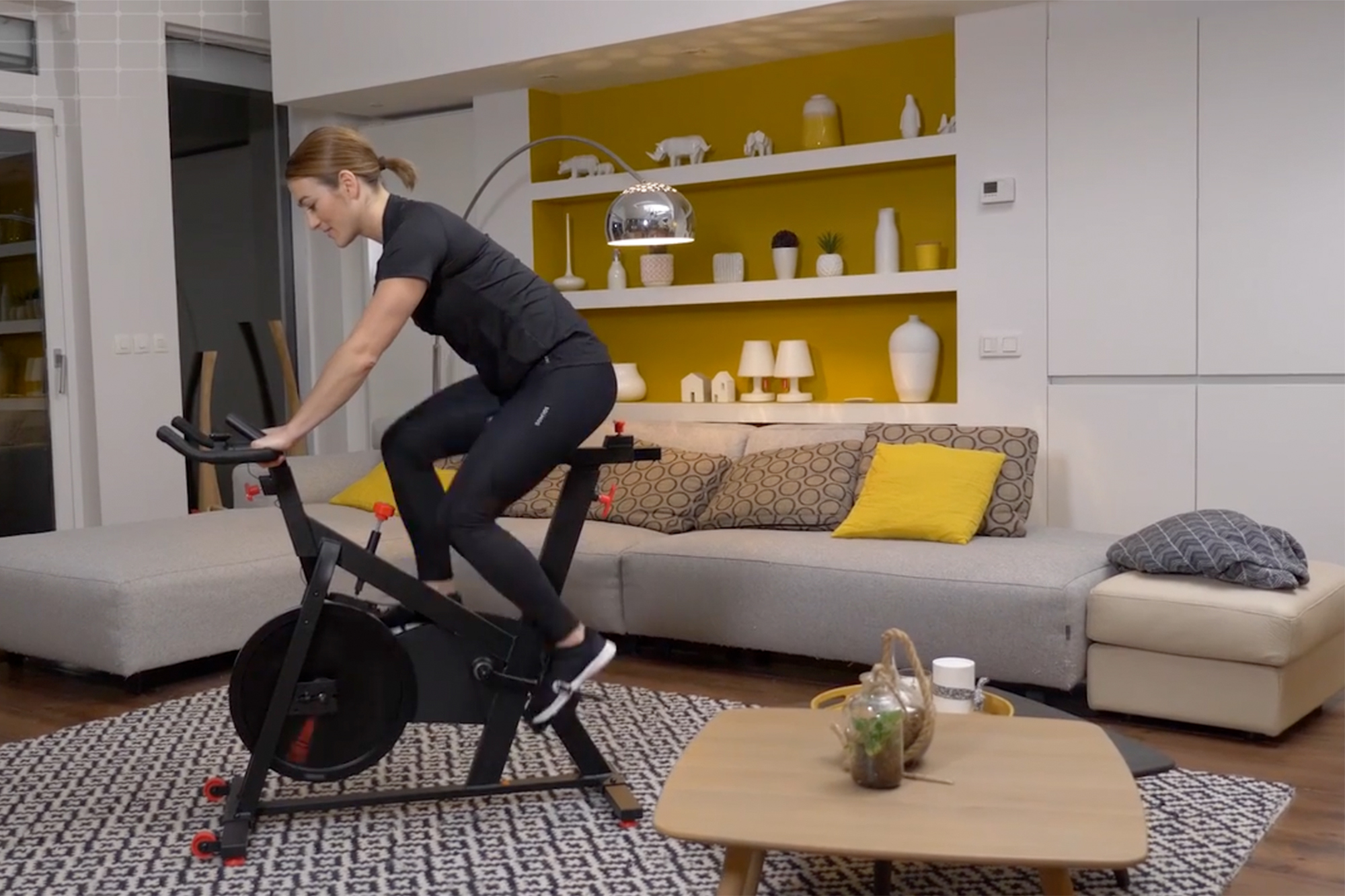
2. Domyos Basic Exercise Bike 100
Best exercise bike on a budget
Resistance: Mechanical resistance and adjustment | Levels of resistance: 32 | Max rider weight: 220lbs/100kg | Height range: Not specified | Bike weight: 63.9lbs/29kgs | Display: Digital | Third party connectivity: No | Subscription required: No
For newcomers to riding at home, the Domyos Basic Exercise bike can be the perfect place to get started. While reviews on the Decathlon house brand website say that it's no studio bike, many applaud its sturdiness and value for money. Arguably with less frequent use, this basic spin bike doesn't need to be quite as robust. This means the Domyos is slightly lighter and more transportable, allowing it to be wheeled out the way when not in use.
A 12kg flywheel uses a mechanically applied leather brake pad to create resistance for the user, in what the brand says is 'moderate-intensity use. A chain-driven drivetrain should recreate a smooth pedalling sensation, similar to that of a normal bike. The saddle height, saddle fore/aft and handlebar height can all be adjusted, similar to that of a regular gym spin bike. Making it easy and quick to find a comfortable position.
There isn't an online community or platform to join, which means you'll have to be self-motivated or find online classes to attend. The Domyos allows the freedom and flexibility of keeping fit with a little homemade spin class at a low cost.
Best budget exercise bike for big efforts
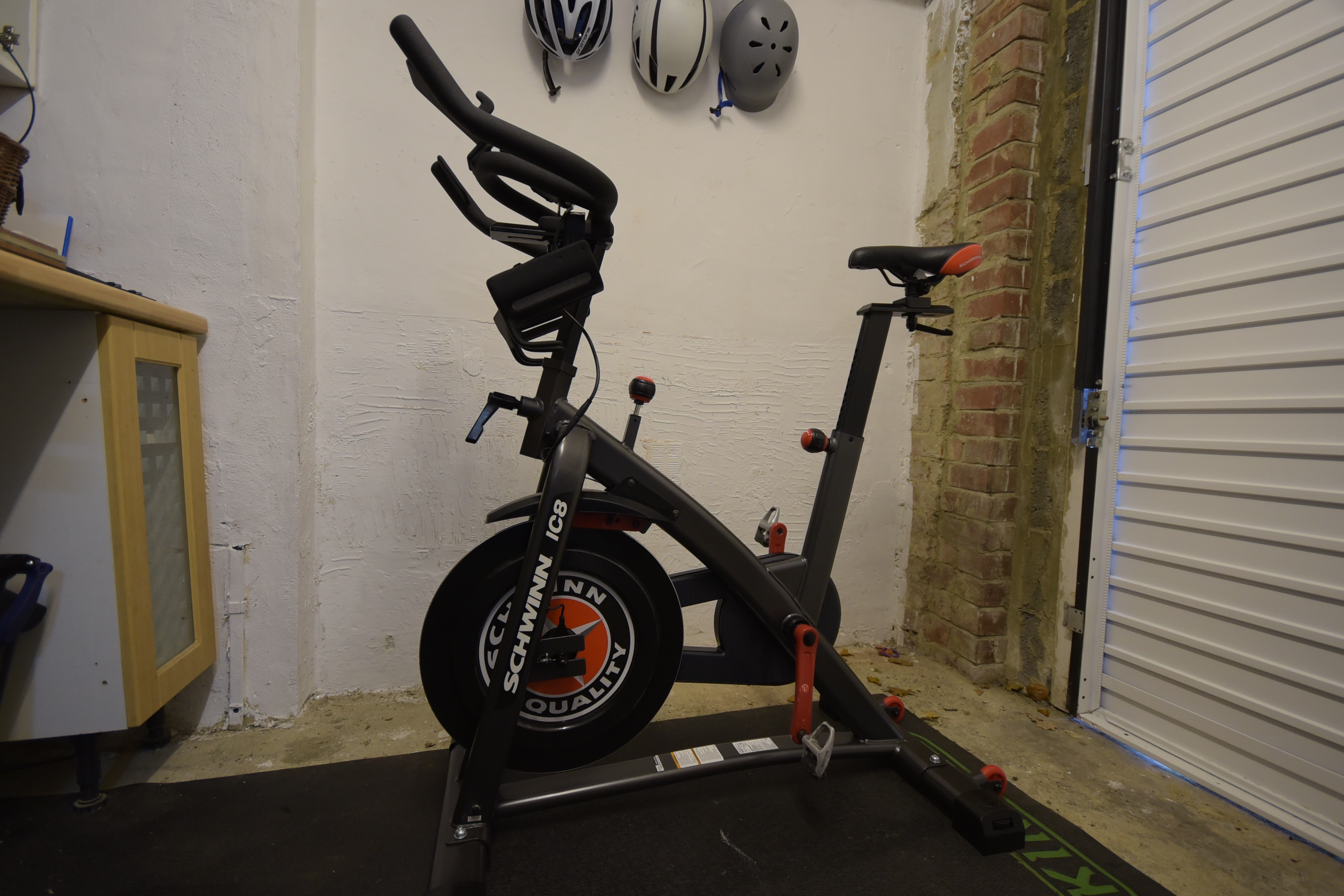
3. Schwinn 800IC Exercise Bike
Best budget exercise bike for big efforts
Resistance: Magnetic | Levels of resistance: 100 | Max rider weight: 330lbs/150kg | Height range: Not specified | Bike weight: 105lbs/48kg | Display: Digital | Third party connectivity: Yes | Subscription required: No
If you've ever undertaken a gym spin class, the chances are that you were riding a Schwinn. That background in gym bikes means very little technical know-how is required to get it set up and ready to ride. For those that may already own spin shoes, it even comes with secure clipless pedals (SPD) out of the box.
Formally, the IC8, this sturdy indoor trainer features a weighty flywheel that is unlikely to be overpowered by most riders. It's a direct-contact resistance system, with a staggering 100 levels to choose from, meaning you are in charge of your training at all times.
The added tablet/phone holder and a wide range of third-party connectivity options mean you can choose which virtual classes to join and enjoy.
The bike's location can be pretty flexible, thanks to mini roller wheels that facilitate transportation. But the weight unit will limit its general living place, and I wouldn't be keen on rolling it or riding it without the use of heavy-duty floor protection.
Read our full Schwinn 800IC Indoor Cycling Exercise Bike review
Best budget option for third-party connectivity
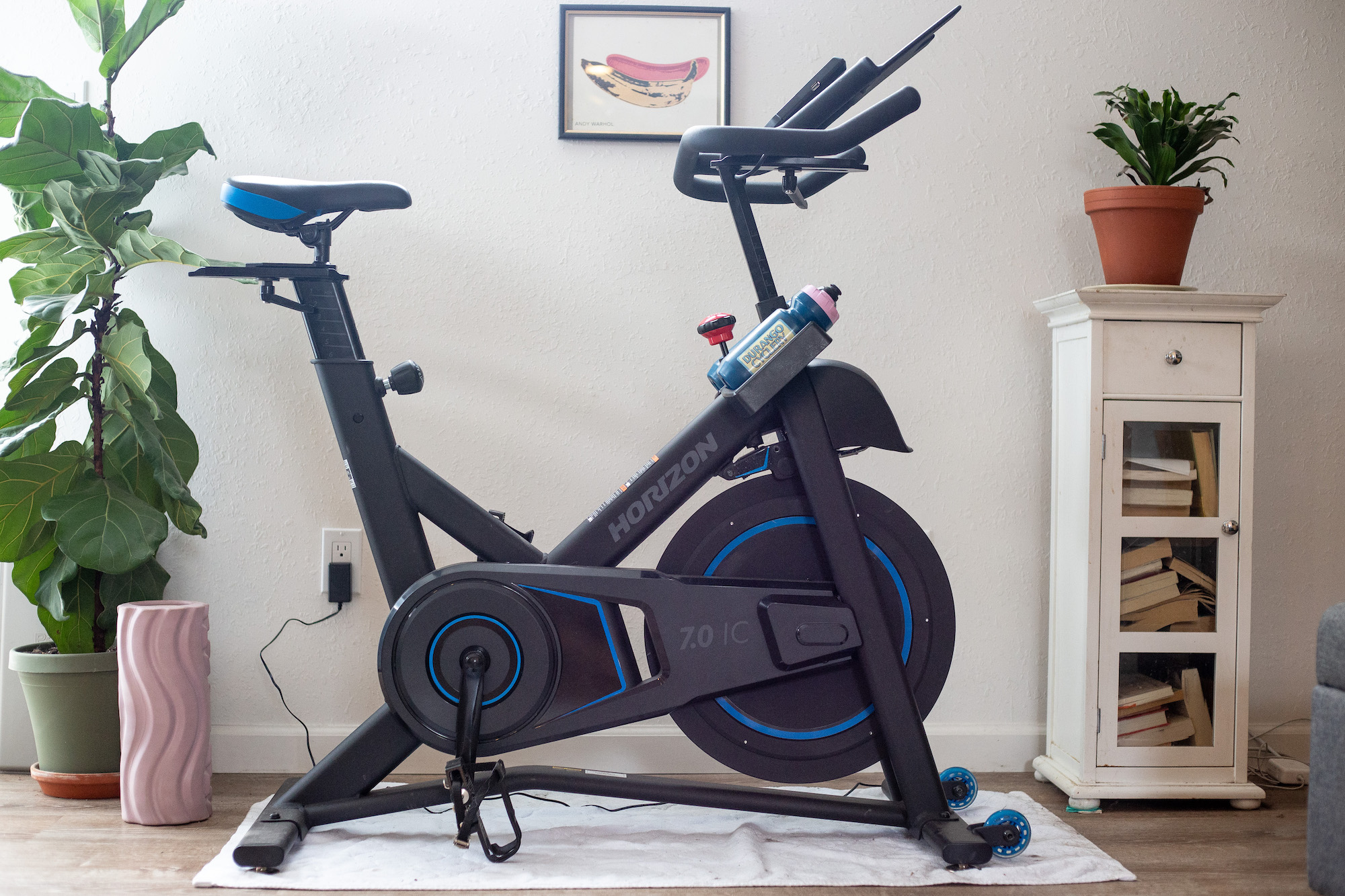
4. Horizon Fitness 7.0 IC Fitness Bike
Best budget exercise bike for third-party connectivity
Resistance: Magnetic | Levels of resistance: 100 | Max rider weight: 300lbs/ 136kg | Height range: Not specified | Bike weight: 87lbs/ 39kg | Display: Digital | Third party connectivity: Yes | Subscription required: No, however, you will if you want classes through Horizon studio or to connect with Zwift etc.
Horizon Fitness offers an indoor exercise kit that costs under $1,000, with the 7.0 IC model including a Bluetooth heart rate monitor. Set-up isn't too laborious, although there's a limited range of adjustment and the saddle is rather hard.
The Horizon Fitness bike features pedals with SPD clips on one side and straps on the other, along with two water bottle holders. It doesn't take up too much space.
You get Bluetooth connectivity, so you can use a phone or tablet to join classes or rides online, and your speed and other metrics will be sent to the app, although you're still going to need to adjust the resistance manually. With a total of 100 levels, there's plenty of fine-resolution and high-end resistance available, and the transition between levels is smooth.
Read our full Horizon Fitness 7.0 IC Fitness Bike review
Best for motivation and community

5. Peloton Indoor Training Bike
Best motivational exercise bike
Resistance: Magnetic | Levels of resistance: 100 | Max rider weight: 297lbs/135kg | Height range: 150cm - 195cm/4'11" - 6'4" | Bike weight: 134lbs/61kg | Display: 21.5" high definition touch screen sound system | Third party connectivity: Yes | Subscription required: No, however, you will if you want classes or be part of the peloton community
"Okay, Peloton, let's do this!" You have almost certainly seen the adverts for this on TV. The brand has been popping up everywhere, and even non-cyclists now know the word 'Peloton'. The American brand dominates the US market and has made inroads into the UK too.
The basic set-up (and membership) includes daily live-streamed classes, as well as 24-hour access to the virtual studio for an entire household. There are curated playlists for all genres, as well as instructors and coaches, and leaderboards to keep you motivated. There are even additional options that include strength, stretch and yoga classes.
It's cheaper than the Wahoo option, but nearly double that of the Echelon, arguably the most significant competitor. If you struggle to plan your own workouts and need motivational entertainment, the Peloton is a great option. There's even the option for individual profiles for household access, so perfect if you're looking for a shared home bike option.
If it all sounds like a tempting offer for virtual cycling, but you are still undecided, take a look at our helpful guide on Zwift vs Peloton: which is best for your at-home workouts?
Read our full Peloton indoor training bike review
Best air resistance exercise bike
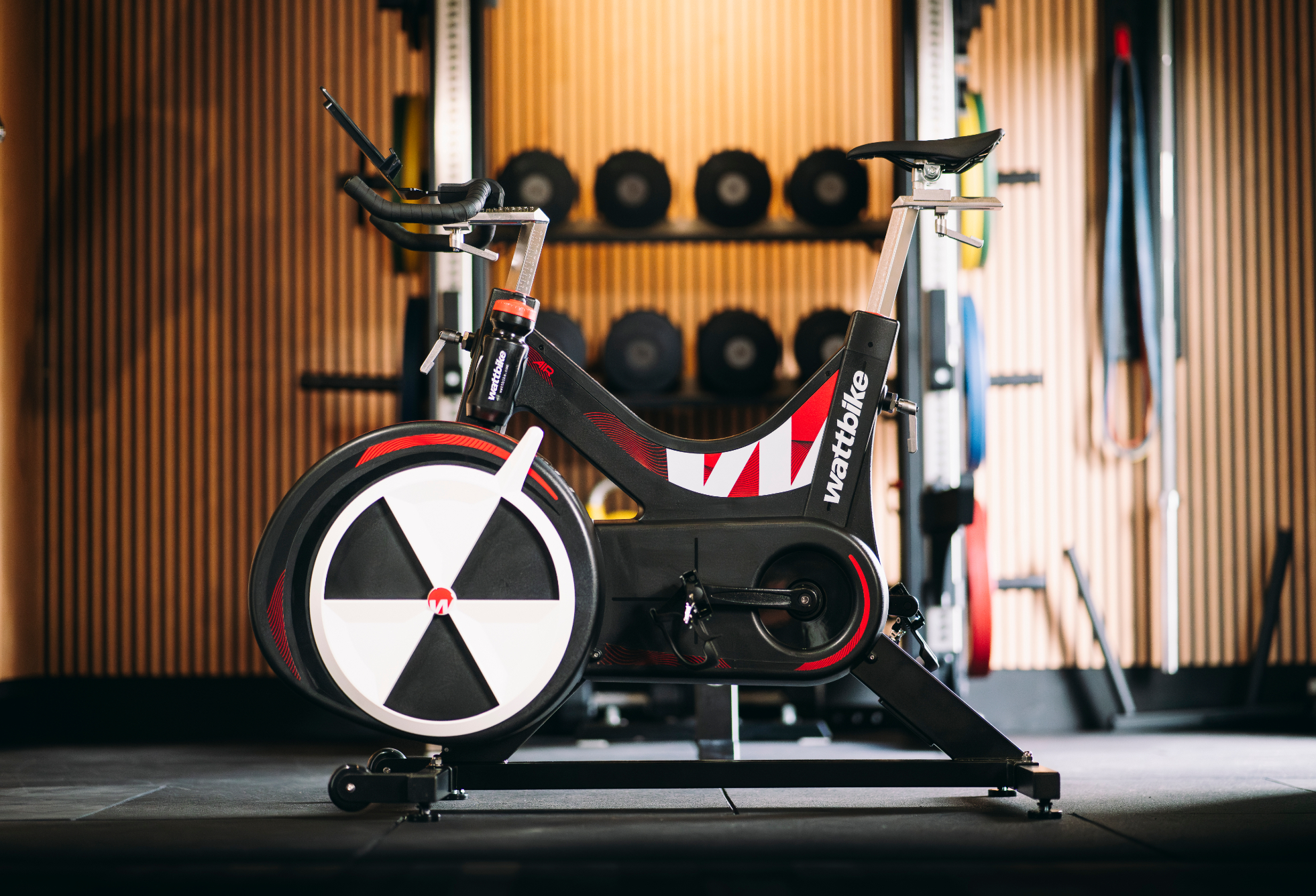
6. Wattbike Air Exercise Bike
Best air resistance exercise bike
Resistance: Air | Levels of resistance: 10 | Max rider weight: 330lbs/150kg | Height range: 5'2" - 6'4"/ 157cm -192cm | Bike weight: 121lbs/ 55kg | Display: None | Third party connectivity: Yes | Subscription required: No
Developed for more than a decade, the Wattbike air resistance system is well-renowned among high-level athletes and fitness coaches. The Wattbike Pro and Trainer Air set the benchmark for those looking to incorporate high-intensity intervals into their training plans. The recently launched Wattbike Air aims to bring this technology into the homes of cyclists and fitness enthusiasts.
What do we know about the air resistance system? The commercial gym versions have huge peak power outputs, with the Pro & Trainer Air achieving 3500-3800 watts. These are the bikes you will have seen Sir Chris Hoy and Laura Kenny using for FTP and sprint efforts. The Air has a far more modest peak, but one that is still far higher than its competition, with potential for riders to try and push 2500 watts.
Air bikes are renowned for being extremely quiet and react nearly immediately to explosive efforts, with a smoothness that can only be achieved using this resistance method. As we found with the Atom Wattbikes, reputation for quality is high. Considering the top-level athletes that use either system every day, we have no doubt the Air would be a good addition to any home gym setup.
Best exercise bike for durability
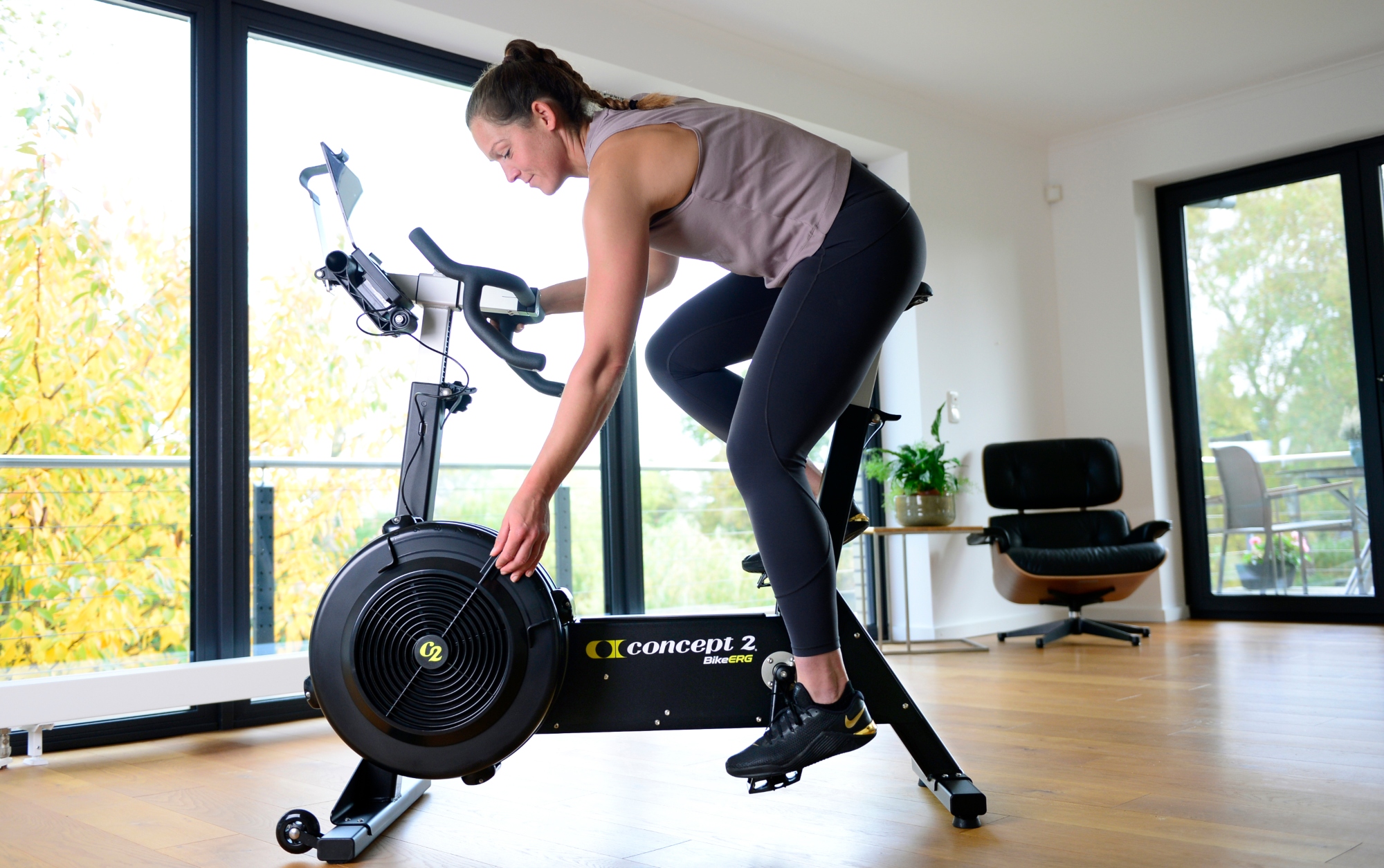
7. Concept 2 BikeErg
Best exercise bike for durability
Resistance: Air | Levels of resistance: N/A | Max rider weight: 350lbs/159kg | Height range: 5' - 6'4"/ 152cm -192cm | Bike weight: 68lbs/31kg | Display: Digital | Third party connectivity: Yes | Subscription required: No
Concept2 is a big name in gym equipment, with its rowing machines considered the gold standard, and this accuracy is carried over into the Concept2 BikeErg exercise bike. Its PM5 power meter measures a host of metrics to give repeatable values from its fan-based resistance unit.
There's no heavy flywheel or magnetic resistance unit here, so the Concept2 BikeErg is lighter than many of its competitors, and it doesn't require a power supply.
Setup was quick, and there's a wide range of tool-free adjustments for all contact points. Shorter or taller riders can purchase a seatpost of a different length to achieve a wider range of inside leg length. You can also swap out handlebars, saddle and pedals, although not the crank length.
On test, the belt drive and air resistance combine for a remarkably smooth and quiet ride. It's easy to do one of Concept2's sessions or to hook up to Zwift for more stimulation; a tablet mount is an extra, though.
On the downside, I found the power measurement to be somewhat inaccurate, although it was consistent in its inaccuracy, which means you just need to do a little maths. The real bugbear is that you need to reach down to the flywheel to alter resistance, rather than having a bar-mounted lever.
Read our full Concept 2 BikeErg review
Specs table
There's a lot to consider if you're looking for the best exercise bike to meet your needs. You'll want to make sure that you've got all the functionality that you want before making what can be a significant outlay on an exercise bike for riding indoors.
Here's a cross-reference table for all the models listed above.
| Header Cell - Column 0 | Connectivity | Weight | Resistance | Adjustment |
|---|---|---|---|---|
Domyos Basic Exercise Bike 100 | No | 29kg | Friction | Manual |
Echelon Smart Connect EX3 | BLE | 47kg | Magnetic | Automatic/manual |
Peloton | BLE/WiFi | 61kg | Magnetic | Automatic/manual |
Horizon Fitness 7.0 IC | BLE | 39kg | Magnetic | Manual |
Schwinn Fitness 800IC | BLE | 48kg | Magnetic | Automatic/manual |
Concept 2 BikeErg | BLE/ANT+ | 31kg | Air | Automatic/manual |
Wattbike Air | ANT+, Bluetooth, FTMS | 55kg | Air | Manual |
How we test exercise bikes
Indoor training is now a central part of most cyclists' fitness regimes. Indoor training apps like Zwift make the experience much more interactive.
Even without the ability to link up to an app, you can get a lot out of indoor cycling. So, at Cycling Weekly, we see ourselves as dedicated indoor trainers and outdoor riders. Our team has used a wide range of exercise bikes and smart trainers and knows what to look for to maximise your fitness gains from riding indoors.
Our experience means you'll have a consistent, in-depth viewpoint reflected in our product scoring. You can find out more on our How We Test page.
The way we test each exercise bike depends on its categorization. For the more basic units that lack connectivity, we are setting out a structure of sessions that best test the unit's stability, the unit's maximum resistance, and how smoothly it is delivered.
Of course, we are also checking the more basic features of units with connectivity or smart features. However, we are also cross-checking the data with power meters, the quality of that connectivity to third-party apps and devices, and particularly the speed at which these connections react and adjust resistance levels.
Where possible, we try to set similar session plans. However, different reviewers will be at different points in their fitness plans, so we are mindful that the plans are not always exact. We will always try to ensure that we complete basic sessions, including intervals, over-unders, cooldowns, recovery, sprints, and some race simulations.
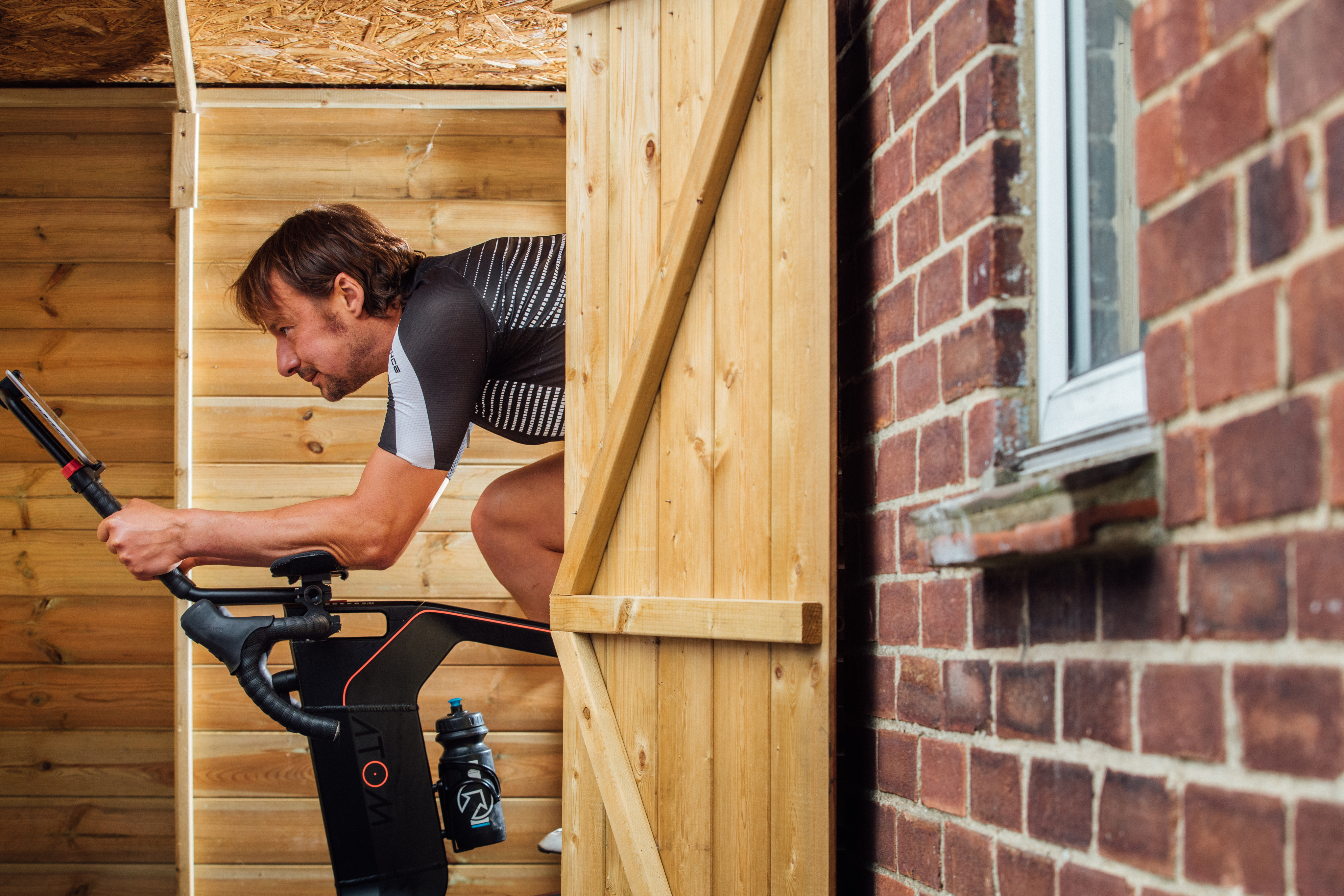
How to choose the best exercise bike for you?
Choosing one of the best exercise bikes, given their crossover with the best smart bikes and various other fitness platforms like Peloton, can become a bit confusing. What we are discussing here is exercise bikes, which are generally defined by the manual intervention required when adjusting the resistance. This is typically accomplished by a dial or handle located on the bike. If you are looking for something that is automatically controlled, you absolutely will want one of the best smart bikes.
So, how do you choose the best exercise bike for you?
- Defining your fitness goals is a good place to start. Depending on whether you are looking to just get some Cardio, rehabilitate, make performance gains or lose weight, will depend on what direction you should consider when selecting a bike. For Cardio/fitness and weight loss, this can be done on just about any exercise bike. Given that you can track this style of exercise fairly accurately with one of the best smartwatches or heart rate monitors, you don't need to spend on more advanced systems. However, you might want to consider offerings like Peloton or Echelon for their more all-around fitness training packages. For more advanced rehabilitation and performance gains, it will be worth looking to those that offer greater connectivity to 3rd-party training platforms.
- Consider the type of exercise bike; we primarily cover the more traditional upright-style bikes here at Cycling Weekly, as they are the most transferable to road and gravel bikes. However, there are several types that offer benefits in specific scenarios. For example, recumbent bikes are handy for rehabilitation, allowing you to focus on the cardio and pedalling without the awkwardness of getting on and off a bike or the need for upper body strength. However, worth considering the adjustability of a bike and if you want to try to replicate a bike fit or not, and the more affordable offerings tend to offer less movement in this area.
- How hard do you want to make it? For a detailed look at the different types of resistance, please refer to my guide in the section below titled Types of exercise bike resistance: explained. In short, the more performance-focused you are, if you are looking to add intervals or any HIIT training to your routine, the greater the resistance you are likely to require. Which has a significant impact on the selection of bikes you can consider.
- Consider your budget and the potential frequency with which you might use an exercise bike. Like anything for all the bells and whistles, you are looking at a price to match, and with some, there are additional subscriptions to access the content, like Peloton. At which point, could a gym membership for X months be more cost-effective, for example?
- Read and digest reviews. I need not mention again our team of cycling and fitness experts here at Cycling Weekly. We are dedicated to providing you with honest and impartial reviews of all cycling-based products. Our team sweats it out throughout the year to ensure you know what you are buying when it comes to the best exercise bikes.

Types of exercise bike resistance: explained
At the heart of most indoor bikes is a weighted flywheel. Its job is to provide mass, which requires energy to establish rotational inertia. In other words, it is a weighted metal disk that takes the place of a bike wheel and is connected to the pedals via either a chain or a belt.
The flywheel stores kinetic energy, so once you’ve got the wheel turning, it will continue to do so, creating a very similar experience to outdoor pedalling.
A good flywheel typically takes force to get it spinning and force to stop it, as kinetic energy is a function of mass and speed. The larger the diameter and heavier the flywheel, the more energy is stored, and the flywheels that spin the fastest store much more energy than ones that spin faster (so keep spinning for longer on their own).
Without external slowing force, a flywheel would create a stop-and-go experience and would need to be very large or spun exceptionally fast to benefit fitness. Using brake pads or electromagnetic induction with magnets can significantly reduce the weight and size of a flywheel for better usability.
Direct-Contact resistance systems
A brake pad is simply applied alongside and on top of the flywheel to create friction which the rider needs to overcome.
The more pressure applied to the pad, the harder it becomes to keep the flywheel moving. It’s that simple.
The downside is, you’ll still require a pretty heavy and large flywheel; think typical gym spin bike, and much like brakes on a bike or a car, over time you’ll find that the brakes will need replacing. Depending on the quality and size of the flywheel, you may eventually find that it needs to be replaced too at some point.
They are also entirely mechanical, so will be noisier than electro-magnetic resistant bikes. So if it’s going to be living in the middle of your lounge, you might need to give advance warning of your impending exercise routine to the rest of the household.
The upside is that this level of simplicity keeps the price down. There are lots of online classes, both paid and free, to sign up to keep you motivated and working hard. These bikes also rarely require electricity, so great for keeping in an outbuilding or, even outside with a protective cover on when not in use.
Electro-Magnetic resistance systems
Recently these have become the pièce de résistance of exercise bikes. By passing an electrical current through magnets you can make the magnets more or less attractive to each other. The resistance in an electromagnetic exercise or smart bike is controlled by the level of electric current passing through the magnets that flank either side of the flywheel. More current equals more magnetic force, increasing the resistance, and making it harder for you to turn it.
The biggest benefit of the electromagnetic resistance system is that it can be controlled by the rider, by pushing a button, running pre-programmed software built into the bike or, with the correct connectivity, a remote third party, allowing for virtual riding on platforms such as Zwift or TrainerRoad.
Another benefit of the electromagnetic system is that because there is nothing in contact with the flywheel creating the resistance, you can significantly reduce its size and weight, making the whole package much smaller and lighter.
Other benefits include less wear and tear, as there are no brakes in contact with the flywheel and the working noise is also significantly reduced.
The downside as well as requiring a source of electricity, is the cost. The initial outlay will be a lot more expensive than a more basic mechanical direct contact resistance bike, and remote third-party virtual reality apps will require a subscription of some kind.
Air resistance systems
Air bikes use a flywheel system based on air to create the resistance and are increasingly popular in gyms since the advent of Crossfit/ Functional fitness and their HIIT style exercises.
Fan like blades are driven by a simple cog and chain/ belt and require the rider’s energy, mostly by co-joined pedal arm levers to turn. The harder you ride, the more resistance the blades meet from air, making you expend more energy.
If you want to cover a set distance or calorie count quickly, you’ll have to push the blades through the air quickly - which requires more force to move air molecules quicker, think of putting your hand out of a moving car window and the force of the wind at low and high speeds.
90% of air bikes will have arms and legs and as the resistance comes from the spinning blade, there’s often no variability.
The upside is that along with getting a full body workout, there’s no need for electricity (other than a new battery once in a while for a head unit display) so it can be located anywhere, another ideal option for the shed or outside under a protective cover.
The downside is that out of all three options, this is by far the noisiest with the harder you work the louder the fan like sound, certainly not household friendly.
Frequently asked questions about exercise bikes
How much does the best exercise bike cost?
The price difference for exercise bikes ranges from $150/£100 for basic models to nearly $3,000/£2,500 for high-end options, often requiring a monthly subscription for full benefits.
Interactive, Wi-Fi-enabled exercise bikes offer a good compromise. They allow users to take online classes for motivational workouts from the comfort of their homes. Although initial costs may be lower than those of smart bikes, monthly subscriptions can increase overall expenses.
An entry-level model is sufficient to get you started; spending more provides features like ANT+ and Bluetooth connectivity for use with apps like Zwift or Rouvy.
Will an exercise bikes help me get fit and loose weight?
Cycling offers many benefits, and indoor riding is no exception. It enhances mental health, boosts immunity, and aids weight loss; why not check out our 15 benefits to cycling guide?
The main advantage of an exercise bike is the control it offers over pace and duration, which allows you to tailor your fitness journey to your needs. For those investing in an exercise bike for weight loss, our quick guide outlines six essential tips for success.
What's the difference between an exercise bike and a smart bike?
The main difference between the two is the functionality. The systems vary hugely in terms of performance, and the more you spend, the more you’ll get.
Generally speaking, an exercise bike, or spin bike, will provide manually adjustable resistance, have some basic performance data, and a more upright sitting position.
A smart bike is more interactive, and, along with automatically controlling resistance for you, it will also allow you to attend virtual rides, gather significant performance data, and have a riding position that more closely mimics that of a road bike, providing a realistic road-like feel when pedalling.
In the middle is an ever-growing market that combines both smart features and connectivity with the simplicity of basic exercise bikes. We also see a rising trend in air-resistance bikes.
What is Peloton and are there alternatives?
The Peloton indoor exercise bike and app have taken the fitness world by storm, but is it any good for training for proper cyclists?
We've got all the insider detail on the question of is the Peloton indoor exercise bike and app worth it on our dedicated page; but in summary:
You'll need to purchase the bike and then subscribe to a membership monthly fee, a bit like a gym, but it does allow you to include multiple members.
The subscription bit gives you access to instructor-led classes, which resemble 'spin classes' and a motivational virtual community, as well as off bike exercises such as Yoga, stretching and strength workouts. So it's a bit like a mini home gym structured around the bike.
While Peloton might still have the market share, there are a lot more options out there if an interactive smart bike is your thing. We've picked out what we think are the best Peloton alternatives to help you find the right bike to achieve your fitness goals.
Which is better: an exercise bike or a turbo trainer?
When it comes to performance training and riding indoors, turbo trainers have traditionally been the way to go. However, with the advent of smart bikes and more coming on the market constantly, some riders have referred to them as game changers for full-gas efforts and harnessing every inch of power due to their solidity. Then there's the reduction in maintenance and the bike always being ready to ride.
However, on the flip side, the compliance offered by a road bike attached to a turbo trainer does have its benefits on longer rides at home. The ability to stow a turbo neatly away, along with the obvious price differences, will be more of a perk for some riders.
Read more on our Smart bike or top-end turbo: what's the ultimate set-up for Zwift racing feature to see what two distinguished online racers think.
What are the pros and cons of foldable exercise bikes?
If space is limited at home, you might be tempted to buy an exercise bike that folds up and rolls away. However, this will always mean some big compromises in terms of performance, most notably rider position and limited tension settings.
A typical foldaway exercise bike uses an ‘X’ frame, similar to an ironing board, to keep its overall footprint low. To keep this dual triangle relatively strong, it must be as vertical as possible, meaning that you're likely to be sitting very upright.
The other obvious disadvantage of foldaway exercise bikes is that, to keep the machine as portable as possible, they will naturally have lighter, much smaller flywheels, significantly reducing their ability to apply resistance.
Clearly, they have their place for people with limited space and looking for a low-impact cardio workout at home. For experienced cyclists, it is certainly worth considering some of the best rollers or smart turbo trainers instead.
Do I need to have a subscription to use an exercise bike?
The short answer is no: all the exercise bikes in this guide will work perfectly well as basic exercise bikes without requiring a subscription, joining a community, or following a structured workout plan. However, your need for connectivity could help to narrow down what kinda of bike you are looking for. If you aren't interested in racing, classes, or joining others, you could look at some of the simpler units, such as the Domyos or Schwinn and save yourself some money.
Even those that offer their own in-house services like Echelon and Hoizon Fitness, you could opt to use one of the best indoor training apps instead, like Zwift, Rouvy or My Whoosh.
The latest race content, interviews, features, reviews and expert buying guides, direct to your inbox!
Hannah is Cycling Weekly’s longest-serving tech writer, having started with the magazine back in 2011. She has covered all things technical for both print and digital over multiple seasons representing CW at spring Classics, and Grand Tours and all races in between.
Hannah was a successful road and track racer herself, competing in UCI races all over Europe as well as in China, Pakistan and New Zealand.
For fun, she's ridden LEJOG unaided, a lap of Majorca in a day, won a 24-hour mountain bike race and tackled famous mountain passes in the French Alps, Pyrenees, Dolomites and Himalayas.
She lives just outside the Peak District National Park near Manchester UK with her partner, daughter and a small but beautifully formed bike collection.
- Matt Ischt-BarnardEcomm and Tech Writer
